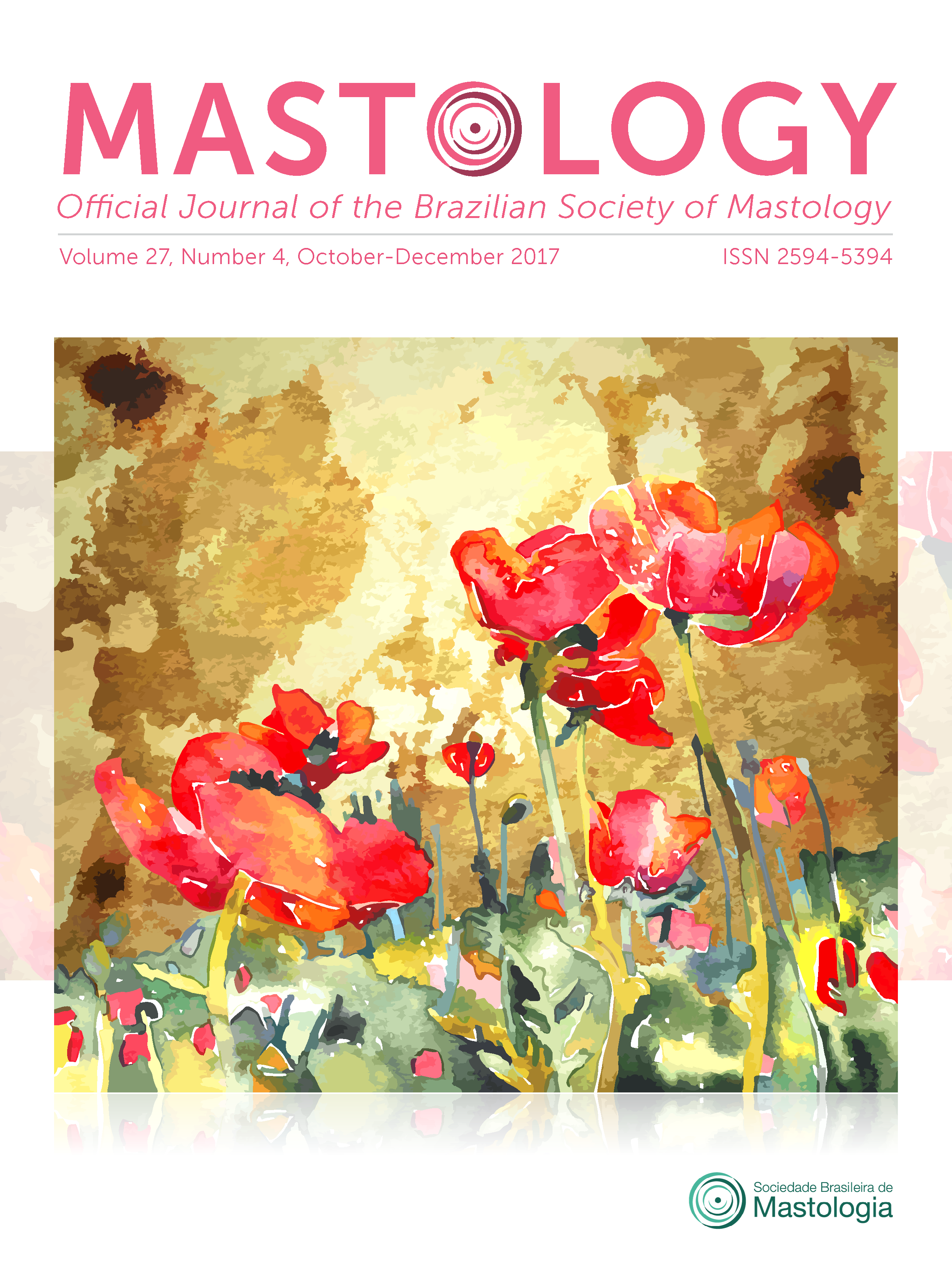Carcinoma invasivo de mama triplo negativo com imunofenótipo basal e não basal
implicações prognósticas
Palavras-chave:
Câncer de mama triplo negativo, mama, neoplasias da mamaResumo
Objetivos: O objetivo do estudo foi correlacionar o estadiamento pós-cirúrgico e a evolução clínica em um período de três anos com as características histopatológicas e imunoistoquímicas consideradas fatores prognósticos e/ou preditivos nas pacientes em tratamento de câncer de mama do tipo triplo negativo do Hospital Barão de Lucena, Recife, Pernambuco. Método: O estudo foi feito com 125 pacientes do sexo feminino portadoras de câncer de mama triplo negativo e que foram submetidas a tratamento cirúrgico no serviço de mastologia do Hospital Barão de Lucena no período de 2009 a 2012. Nessas pacientes foram estudadas as características clínicas e patológicas dos tumores, as quais foram correlacionadas com os subtipos basal e não basal. A análise descritiva dos dados foi feita através de tabelas e/ou gráficos para variáveis qualitativas. Para análise de associação, foi utilizado o teste do χ2 para independência. Nas tabelas que apresentaram frequência esperada menor que 5, em mais de 20% das caselas, foi utilizado o teste exato de Fisher. Além disso, foi calculada a razão de chance (OR) e o intervalo de confiança (IC) para OR. Em toda a análise foi considerado nível de significância de 5%. Resultados: A média de idade foi de 49 anos; com relação à raça, tivemos a cor negra em 83 (66,4%) delas. O tipo histológico mais comum foi o ductal, em 111 (88,8%) pacientes. O estágio patológico I/II foi o mais comum, em 87 (69,6%) delas. Um total de 71 (56,8%) pacientes não demonstrou comprometimento axilar. Com relação ao tipo de cirurgia, a conservadora foi utilizada em 57 (45,6%) pacientes, incluindo setorectomia e técnicas de oncoplastia. A recorrência esteve presente em 30 pacientes, sendo basal em 16 (53,3%) e não basal 14 (46,7%) delas, nas quais a metástase óssea foi a mais frequente. Conclusão: Nessa amostra de tumores triplo negativo, os fatos mais importantes associados à sobrevida foram a idade abaixo de 40 anos, o tipo histológico, a citoqueratina CK5/6 e o grau de significância maior dos fatores EGFR e KI-67.
Downloads
Referências
Tavassoli FA. Normal development and anomalies of the breast. In: Pathology of the Breast; 2003. p. 45.
American Cancer Society. Leading sites of new cancer cases and deaths-2007 estimates [Internet]. 2007 [cited 2017 nov 22]. Available from: https://www.cancer.org/content/dam/cancerorg/research/cancer-facts-and-statistics/annual-cancerfacts-and-figures/2017/leading-sites-of-new-cancer-casesand-deaths-2017-estimates.pdf
Page DL, Dupont WD. Anatomic markers of human premalignancy and risk of breast cancer. Cancer. 1990;66(Suppl 6):1326-35.
van’t Veer LJ, Dai H, van de Vijver MJ, He YD, Hart AA, Mao M, et al. Gene expression profiling predicts clinical outcome of breast cancer. Nature. 2002;415(6871):530-6. DOI: 10.1038/415530a
Page DL, Jensen RA, Simpson JF. Routinely available indicators of prognosis in breast cancer. Breast Cancer Res Treat. 1998;51(3):195-208.
Lakhani SR, Ellis, IO, Schnitt SJ, Tan PH, van de Vijver MJ. WHO classification of tumors of the breast. Lyon: IARC Press; 2012.
Reis-Filho JS, Westbury C, Pierga JY. The impact of expression profiling on prognostic and predictive testing in breast cancer. J Clin Pathol. 2006;59(3):225-31. DOI: 10.1136/jcp.2005.028324
Wolff AC, Hammond ME, Schwartz JN, Hagerty KL, Allred DC, Cote RJ, et al. America society of clinical oncology/college of america pathologists guideline recommendations for human epidermial growth factor receptor 2 testing in breast cancer. Arch Pathol Lab Med. 2007;131(1):18-43. DOI: 10.1043/1543-2165(2007)131[18:ASOCCO]2.0.CO;2
Hammond ME, Hayes DF, Dowsett M, Allred DC, Hagerty KL, Badve S, et al. American society of clinical oncology/ college of american pathologists guideline recommendations for immunohistochemical testing of estrogen and progesterone receptors in breast cancer. Arch Pathol Lab Med. 2010;134(7):e48-72. DOI: 10.1043/1543-2165-134.7.e48
American College of Radiology. Mammography. In: Illustrated breast imaging reporting and data system (BI-RADS). 4th ed. Reston: American College of Radiology; 2003.
Pascalicchio JC, Fristachi CE, Baracat FF. Câncer da mama: fatores de risco, prognósticos e preditivos. Rev Bras Mastol. 2001;11:71-84.
Colleoni M, Rotmensz N, Peruzzotti G, Maisonneuve P, Orlando L, Ghisini R, et al. Role of endocrine responsiveness and adjuvant therapy in very young women (bellow 35 year) with operable breast cancer and node negative disease. Ann Oncol. 2006;17(10):1497-503. DOI: 10.1093/annonc/mdl145
Goldhirsch A, Ingle JN, Gelber RD, Coates AS, Thürlimann B, Senn HJ. Thresholds for therapies: highlights of the St Gallen International Expert Consensus on the primary therapy of early breast cancer 2009. Ann Oncol. 2009;20(8):1319-29. DOI: 10.1093/annonc/mdp322
Sales RA, Mcguire WL, Clark GM. Prognostic factors in breast cancer. Semin Surg Oncol. 1989;5(2):102-10.
Albain KS, Allred DC, Clark GM. Breast cancer outcome and predictors of outcome: are there age differentials? J Natl Cancer Inst Monogr. 1994;(16):35-42.
van Belle V, van Calster B, Brouckaert O, Bempt IV, Pintens S, Harvey V, et al. Qualitative assessment of the progesterone receptor and HER-2 improves the nottingham prognostic index up to 5 years after breast cancer diagnosis. J Clin Oncol. 2010;28(27):4129-34. DOI: 10.1200/JCO.2009.26.4200
Nixon AJ, Neuberg D, Hayes DF, Gelman R, Connolly JL, Schnitt S, et al. Relationship of patient age to pathologic features of the tumor and prognosis for patients with stage I or II breast cancer. J Clin Oncol. 1994;12(5);888-94. DOI: 10.1200/JCO.1994.12.5.888
Colonna M, Delafosse P, Uhry Z, Poncet F, Arveux P, Molinie F, et al. Is breast cancer incidence increasing among young women? An analysis of the trend in France for the period 1983-2002. Breast 2008;17(3):289-92. DOI: 10.1016/j.breast.2007.10.017
Sidoni A, Cavaliere A, Bellezza G, Scheibel M, Bucciarelli E. Breast cancer in young women: clinicopathological features and biological specificity. Breast. 2003;12(4):247-50.
Slamon DJ, Clark GM, Wong SG, Levin WJ, Ullrich A, McGuire WL. Human breast cancer: correlation of relapse and survival with amplification of the Her-2/neu oncogene. Science. 1987;235(4785):177-82.
Dati C, Muraca R, Tazartes O, Antoniotti S, Perroteau I, Giai M, et al. C-erbB-2 and ras expression levels in breast cancer are correlated and show a co-operative association with unfavorable clinical outcome. Int J Cancer. 1991;47(6):833-8.
Clark GM. Interpreting and integrating risk factors for patients with primary breast cancer. J Natl Cancer Inst Monogr. 2001:17-21.
Farzadnia M, Meibodi NT, Shandiz Fh, Mahmoudi M, Bahar M, Memar B, et al. Evaluation of HER2/neu oncoprotein in serum and tissue samples of women with breast cancer: correlation with clinicopathological parameters. Breast. 2010;19(6):489-92. DOI: 10.1016/j.breast.2010.05.012
Newman LA, Mason J, Cote D, Vin.Y, Carolin K, Bouwman D, Colditz GA. African-American ethnicity, socioeconomic status, and breast cancer survival: a meta-analysis of 14 studies involving over 10,000 African-American and 40,000 White American patients with carcinoma of the breast. Cancer. 2002;94(11):2844-54. DOI: 10.1002/cncr.10575
Elledge RM, Clark GM, Chamness GC, Osborne CK. Tumor biologic factors and breast cancer prognosis among white, Hispanic, and black women in the United States. J Natl Cancer Inst. 1994;86(9):705-12
Carey LA, Perou CM, Livasy CA, Dressler LG, Cowan D, Conway K,. Race, breast cancer subtypes, and survival in the Carolina breast cancer study. JAMA. 2006;295(21):2492-502. DOI: 10.1001/jama.295.21.2492
Lund MJ, Trivers KF, Porter PL, Coates RJ, Leyland-Jones B, Brawley OW, et al. Race and triple negative threats to breast cancer survival: a population-based study in Atlanta, GA. Breast Cancer Res Treat. 2009;113(2):357-70. DOI: 10.1007/s10549-008-9926-3
Carvalho FM, Bacchi LM, Pincerato KM, Van de Rijn M, Bacchi CE. Geographic differences in the distribution of molecular subtypes of breast cancer in Brazil. BMC Womens Health. 2014;14:102. DOI: 10.1186/1472-6874-14-102
Tavassoli FA, Devilee P. Pathology and genetics of tumors of the breast and female genital organs. Lyon: WHO/IARC; 2003.
Simpson JF, Page DL. Prognostic value of histopathology in the breast. Semin Oncol. 1992;19(3):254-62.
Diab SG, Clark GM, Osborne CK, Libby A, Allred DC, Elledge RM. Tumor characteristics and clinical outcome of tubular and mucinous breast carcinomas. J Clin Oncol. 1999;17(5):1442-8. DOI: 10.1200/JCO.1999.17.5.1442
Arpino G, Bardou VJ, Clark GM, Elledge RM. Infiltrating lobular carcinoma of the breast: tumor characteristics and clinical outcome. Breast Cancer Res. 2004;6(3):r149-56. DOI: 10.1186/bcr767
Tot T. The diffuse type of invasive lobular carcinoma of the breast: morphology and prognosis. Virchows Arch. 2003;443(6):718-24. DOI: 10.1007/s00428-003-0881-4
Carter CL, Allen C, Henson DE. Relation of tumor size, lymph node status, and survival in 24,740 breast cancer cases. Cancer. 1989;63(1):181-7.
Downloads
Publicado
Como Citar
Edição
Seção
Licença
Copyright (c) 2017 Darley de Lima Ferreira Filho, Nancy Cristina Ferraz de Lucena Ferreira, Maria do Carmo Abreu e Lima, Alvaro Antonio Bandeira Ferraz, Danyelly Bruneska Gondim Martins, Thais de Lucena Ferreira

Este trabalho está licenciado sob uma licença Creative Commons Attribution 4.0 International License.







